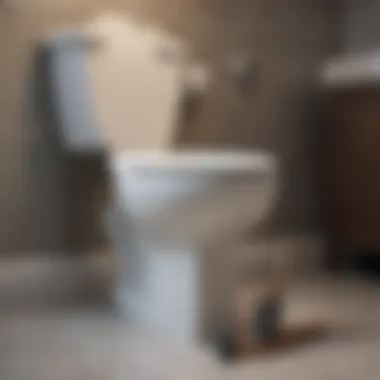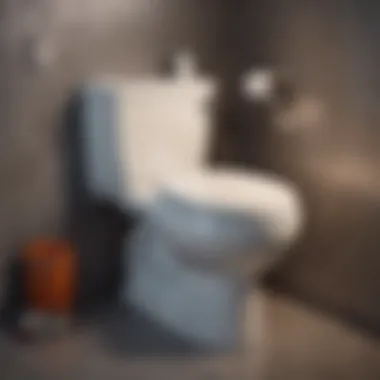Effective Strategies for Unclogging a Toilet


Intro
A clogged toilet can be an unexpected dilemma for any homeowner. These issues disrupt daily life and can even lead to more significant problems if not addressed promptly. Understanding the nature of clogs, their causes, and the appropriate response strategies is essential for effective maintenance and repair. The ensuing sections will explore various techniques and tools available to deal with toilet blockages while also touching upon preventative measures that can minimize future incidents.
This article serves as a practical guide, offering insights that blend professionalism with accessible advice. Ultimately, the goal is to empower homeowners with knowledge that allows for a more efficient and informed approach to dealing with common toilet challenges.
Understanding Toilet Clogs
Toilet clogs are a prevalent household issue that many individuals will encounter at some point. Understanding toilet clogs is vital because it aids in effectively diagnosing and rectifying the problem. When one is cognizant of what causes these blockages, it reduces frustration and enhances the success rate of resolutions. It is not merely about dealing with the immediate issue but also preventing future occurrences.
Understanding the nature of toilet clogs means acknowledging the impact of daily activities on our plumbing. It encompasses a recognition of materials that shouldn't be disposed of in toilets, such as excessive toilet paper, sanitary products, and foreign objects. Knowing these factors can assist individuals in making informed decisions regarding their usage habits.
What Causes Toilet Clogs
Toilet clogs occur due to a mix of various materials that build up over time. The primary culprits often include:
- Excessive toilet paper: Many individuals underestimate the volume of toilet paper they use. When flushed in large quantities, it can accumulate and form a solid mass, causing blockage.
- Sanitary products: Items like tampons and pads are not designed for toilet disposal. They do not break down and can easily create a clog.
- Foreign objects: Toys or other items, sometimes dropped unintentionally into the toilet, can lead to significant blockages.
- Mineral buildup: Hard water can leave mineral deposits that thin the interior pipes over time, leading to slower drainage and eventual clogs.
Understanding these causes allows homeowners to take preventive measures and enhances their ability to unclog effectively when needed.
Common Signs of a Clog
Recognizing the signs of a clog early can save time and prevent further complications. Some common indications include:
- Slow drainage: If water takes longer than usual to disappear after flushing, a clog may be developing.
- Gurgling sounds: Unusual noises from the toilet after flushing can signal trapped air due to blockages.
- Backups: Water or sewage backing up in the toilet or other drains in the home can point to a serious clog in the plumbing system.
- Overflowing toilet: If you notice water spilling over the edges of the bowl, immediate action may be required to prevent further damage.
Staying vigilant about these signs allows individuals to address issues promptly, maintaining the proper functionality of their toilets and preventing more severe plumbing issues.
Initial Assessment of the Clog
Before embarking on any endeavors to clear a toilet clog, an initial assessment is essential. This stage serves as the foundation for selecting the most effective unclogging strategies. Understanding the nature and severity of the blockage can lead to informed decision-making and potentially save time and resources. Inadequate assessment may exacerbate the issue or cause unnecessary damage.
Identifying the Severity of Clogs
Determining the severity of a clog is an important first step. Not all clogs are created equal; some may be minor and easily cleared, while others may indicate more significant issues. A minor blockage might restrict the flow, leading to slow drainage, whereas a severe clog can result in a complete inability to flush.
When assessing a clog, consider:
- Nature of the obstruction: Is the blockage caused by organic matter, toilet paper, or foreign objects?
- Water levels in the bowl: A high water level may indicate a severe clog, whereas a normal or low water level could suggest a minor issue.
- Sounds during flushing: Unusual sounds may reveal air trapped in the system or indicate a deeper problem within the plumbing.
Determining the Source of the Problem
Identifying the source of the clog is crucial in addressing the problem effectively. Several common culprits can lead to toilet blockages.
- Inappropriate items: Items such as feminine hygiene products, wipes, or toys can cause significant obstructions. It is vital to examine what has transpired before the clog occurred.
- Excessive toilet paper usage: Overstocking the toilet with paper can also lead to blockages. Understanding user habits can offer insight.
- Plumbing issues: Sometimes, clogs are not due to the user's actions but rather reflect underlying plumbing problems. Old pipes, poor drainage configurations, and tree root intrusions can all contribute to recurring clogs.
A thorough evaluation of these factors can help determine whether the solution involves a simple plunging or if further investigation and potential plumbing repairs are needed. Proper assessment reduces frustration and enhances the effectiveness of chosen unclogging methods.
Essential Tools for Unclogging
Essential tools for unclogging a toilet are pivotal to effectively tackling clogs. When dealing with a blocked toilet, having the right tools ensures efficient resolution without causing further complications. Tools can significantly minimize the time and effort needed for unclogging. Proper selection of tools prevents damage to the toilet and its plumbing. Understanding how and when to use these tools is equally important in achieving successful results.
Plungers: A Household Staple
Plungers are among the first tools many individuals reach for during a clog emergency. Their design is specifically tailored to create a vacuum effect, which helps dislodge blockages. Typically, plungers come in two varieties: the cup plunger, which is ideal for toilets, and the flange plunger, which has an extended rubber part that fits into the toilet bowl's drain.
To use a plunger effectively, first ensure a proper seal around the toilet drain. Position the plunger so that it fully covers the hole, then apply downward pressure gradually before pulling upwards sharply.


Plunging involves both downward and upward strokes. This motion creates the necessary force to push through blockages.
If done correctly, a few cycles should clear the clog. It is vital to keep the process steady without excessive force, as too much pressure could crack the bowl.
Toilet Augers: When Plungers Fail
When plunging fails to clear the clog, a toilet auger may be your next best option. A toilet auger, also known as a plumbing snake, is a long, flexible tool designed specifically for toilets. It is particularly effective for clogs that are deeper within the plumbing system.
Using a toilet auger involves inserting the flexible cable into the toilet bowl and rotating the handle. The cable extends through the pipes, allowing you to reach blockages that a plunger cannot access. Once the auger encounters a clog, it can either break it up or retrieve materials causing the blockage.
Care should be taken to avoid scratching the ceramic of the toilet bowl while using an auger. Following the manufacturer's instructions is essential for optimal results.
Wet/Dry Vacs: A Versatile Option
Lastly, a wet/dry vacuum offers a non-invasive solution if manual methods prove ineffective. This tool is especially useful when dealing with significant clogs or when foreign objects have been unintentionally flushed.
A wet/dry vac can extract debris from the toilet. First, remove excess water from the toilet bowl using a bucket. Then, create a tight seal around the drain using the vacuum's hose. Turn on the device to pull out the clog. Be sure to use high suction power for the best results.
This method is advantageous because it does not involve harsh chemicals or excessive force, making it safer for the toilet and plumbing. However, proper safety precautions must be taken to avoid spills, especially if the vac is used in confined spaces.
Manual Techniques for Clog Removal
Manual techniques for clog removal are essential for addressing toilet blockages effectively. These methods offer direct and immediate solutions without relying on chemical agents that could harm plumbing systems. They empower individuals to take charge of their plumbing issues and can often resolve the problem quickly. Understanding the proper techniques minimizes damage to the toilet and reduces the risk of escalating the situation by relying on tools and methods that are not suited for the specific issue at hand.
Plunging Methodology
Plunging is a tried-and-true method for unclogging toilets and is often the first step to take when facing a blockage. When using a plunger, select one specifically designed for toilets, ideally a flange plunger. This type maximizes suction and is more effective in creating the right pressure.
To plunge effectively, follow these steps:
- Ensure a good seal: Position the plunger over the drain hole, making sure it covers the hole entirely.
- Use controlled thrusts: Start with gentle thrusts to eliminate excess air. Gradually increase your force and repeat the motion for about 20 seconds.
- Check for progress: After several thrusts, pull the plunger away to see if the water drains.
- Repeat if needed: If necessary, repeat the process until the clog clears.
Effective plunging can resolve many clogs with minimal effort and no mess.
Using a Toilet Auger Effectively
When plunging does not work, a toilet auger, or plumber's snake may be the best next option. This tool is designed to navigate the bends and turns of a toilet’s plumbing.
To use a toilet auger:
- Insert the auger: Carefully guide the cable into the toilet, ensuring not to scratch the porcelain.
- Crank it slowly: As you push the auger deeper, start turning the handle slowly. This movement will help dislodge or break up the obstruction.
- Withdraw gently: Once you feel resistance decrease, withdraw the auger gently. Make sure to retrieve any debris that might come out with it.
- Test the toilet: Flush the toilet to see if water flows freely.
These steps provide a systematic approach ensuring that you can tackle more stubborn clogs without damaging your toilet.
Employing a Wet/Dry Vac
A wet/dry vac is versatile and can be a powerful ally in unclogging toilets. It is particularly useful for removing water from the bowl prior to using other methods. Here’s how to utilize a wet/dry vac:
- Prep the area: Ensure that the vacuum is set for liquids and create a tight seal at the toilet's drain.
- Vacuum the water: Start the vacuum and remove all water from the bowl. This will help you see the obstruction clearly.
- Attach the hose: Use the hose attachment to reach into the drain. Move it in and out to create suction against the clog.
- Flush to test: Once the vacuuming is complete, flush the toilet to check if the issue has been resolved.
Employing these manual techniques not only saves time but can also provide a cost-effective solution for toilet clogs. Knowing the right methods and tools to use is vital when tackling plumbing challenges.
Chemical Solutions to Clogs
Chemical solutions can be a controversial topic when it comes to unclogging toilets. Many people seek quick fixes, often looking for immediate results. This section will dive into the advantages and disadvantages of chemical drain cleaners, as well as exploring natural alternatives. Understanding the right approach to resolve clogs efficiently is crucial for both home and business owners.
Understanding Chemical Drain Cleaners


Chemical drain cleaners often come in two main types: acidic and alkaline. Each type has distinct properties that target clogs differently.
- Acidic cleaners work by breaking down organic matter through strong acid formulations, making them effective for certain types of clogs. However, they can be very hazardous to handle, requiring gloves and goggles for safety.
- Alkaline cleaners, on the other hand, often contain lye or soda ash and can dissolve fats and greases, which are common culprits in toilet clogs.
Chemical cleaners are fast-acting. Users can often see results within a short period of application. However, it is essential to read the instructions carefully. Misuse can lead to damaged plumbing systems and unintended reactions, especially if used in conjunction with other chemicals. They might also cause harm to the environment due to the chemicals they release into the water systems.
Natural Alternatives to Chemical Cleaners
For those looking to avoid harsh chemicals, natural alternatives can be effective. Many of these methods utilize household items, which are often safe for both plumbing and the environment.
- Baking Soda and Vinegar: This combination creates a fizzy reaction that can help dislodge clogs. Simply pour one cup of baking soda followed by one cup of vinegar into the toilet, then wait for about 30 minutes before flushing with hot water.
- Salt: Adding salt to the mix of baking soda and vinegar can enhance the cleaning process. Salt acts as a mild abrasive and can help break down blockages.
- Hot Water: Pouring a bucket of hot water directly into the toilet can sometimes help clear minor clogs. The heat can help dissolve fat or other materials that create blockages.
"Choosing natural alternatives often proves to be safer for plumbing and the environment, making them an attractive option for many homeowners."
These natural solutions require more time and patience compared to chemical approaches, but they are generally safer and more eco-friendly. Additionally, incorporating these methods into regular toilet maintenance can significantly reduce the risk of clogs in the first place.
Preventing Future Clogs
Toilet clogs can cause significant inconvenience and lead to costly repairs. Hence, understanding how to prevent future clogs is essential for maintaining toilet functionality. Good practices not only save time but also protect plumbing from damage. This section highlights the importance of proper usage, maintenance, and recommended inspection practices to ensure smooth operation.
Correct Usage and Maintenance
Understanding how to use the toilet correctly helps in preventing clogs. Avoid flushing inappropriate items like wipes, feminine products, or paper towels, as these do not break down easily.
Maintenance is also crucial. Regular cleaning of the toilet bowl and components can hinder build-up over time.
- Use a non-abrasive cleaner to maintain the toilet's interior.
- Check the flapper valve periodically to ensure it closes properly to avoid leaks.
- Inspect the water level in the tank. The right level helps in effective flushing.
Regularly maintaining these components can prevent some clogs before they occur.
Regular Inspection Practices
Frequent inspections can identify potential issues before they escalate into major problems. A proactive approach is advantageous for avoiding future plumbing disruptions. Consider a routine check-up on these items:
- Check for slow drainage: If the bowl drains slower than normal, it may indicate an impending clog.
- Inspect the vent stack: Ensure it is clear of debris. A blocked vent prevents proper air circulation, causing problems in drainage.
- Look for leaks: Any signs of leaks should be addressed promptly to prevent excess moisture that can lead to mold.
Regular inspections help to identify potential issues early, saving homeowners both time and money in the long run.
By focusing on correct usage and employing regular inspections, one can significantly reduce the possibility of toilet clogs. This approach also ensures the longevity of the plumbing system, making efficient toilet function a realistic goal for every household.
What to Avoid When Unclogging
When dealing with the unpleasant task of unclogging a toilet, understanding what to avoid is crucial. Missteps can lead to prolonged issues, potential damage, or even personal injury. This section addresses key pitfalls in the unclogging process, emphasizing the importance of careful techniques and safety measures.
Misuse of Tools
Improper use of unclogging tools is a frequent issue many encounter. Tools like plungers, toilet augers, and wet/dry vacs are designed for specific tasks. Using them incorrectly can exacerbate the problem or cause damage to the toilet itself. For instance, a plunger used without adequate suction or force might not dislodge the clog at all. Instead, ineffective plunging could simply push the blockage further down the drain.
Moreover, using a toilet auger inappropriately can lead to scratches or breaks in the toilet's porcelain structure. It's vital to learn the correct method of applying these tools to preserve the integrity of the toilet and achieve desired results. Take time to familiarize yourself with the functionality of each tool to avoid costly repairs.
Neglecting Safety Precautions
Safety should always be at the forefront of any unclogging endeavor. Neglecting basic safety measures can lead to health risks and accidents. Various toilet clogs may involve hazardous materials, particularly if the blockage is the result of non-biodegradable items or hazardous chemicals.
Wear appropriate gloves to protect your hands from germs and potential toxic substances. Eye protection may also be necessary, especially when using chemicals or vigorous force with tools like plungers or augers. It is advisable to have a clear area to work in, ensuring no slip hazards are present.
"Taking the time to prioritize your safety can prevent injuries and enhance your unclogging experience."


When to Call a Professional
Addressing toilet clogs can often become a do-it-yourself task for many homeowners. However, there are instances when it is wise to call a professional plumber. Recognizing these moments is key to avoiding further complications and potential damage to your plumbing system.
Identifying Complex Clogs
Not all clogs are created equal. Some might appear simple, but intricate issues may lie beneath the surface. Complex clogs can arise from various reasons such as:
- Multiple toilets backing up simultaneously, indicating a larger issue within the plumbing system.
- Persistent blockages that resist even the most effective plunging and auger techniques.
- Unusual odors emanating from the toilet, suggesting potential sewer line issues.
If a clog has persisted after multiple attempts to clear it, it may signal a blockage deeper within the system, such as tree roots infiltrating the pipes or significant deterioration of plumbing materials. In such cases, enlisting a professional can save time and stress, ultimately preventing further damage to your home's plumbing.
Understanding Plumbing Systems
Having a fundamental understanding of your home's plumbing system provides insight into when to seek professional help. Plumbing systems are intricate, comprising pipes, fixtures, and systems designed to manage waste and supply clean water.
Challenges regarding plumbing can manifest due to:
- Aging infrastructure, which can lead to more frequent clogs and leaks.
- Incorrect installation of plumbing fixtures, leading to complications and continuous issues.
- The potential need for upgrades to accommodate modern plumbing standards.
Understanding these elements allows homeowners to recognize beyond surface problems. If the toilet issues are frequently recurring or are linked with other fixtures showing similar symptoms, then you might not be dealing only with a simple clog.
Case Studies of Toilet Clogs
Understanding toilet clogs is essential in mitigating issues that arise in both residential and commercial settings. Case studies serve as a practical lens through which one can analyze the complexities of clogged toilets. By exploring real-world examples, individuals can identify patterns, discover effective solutions, and learn from the mistakes of others. Each case study highlights the significance of appropriate responses and further reinforces the need for preventative measures.
Residential Experiences
In many households, toilet clogs are frequent occurrences. A common case involves a young family where toys unintentionally find their way into the toilet. Initially, the family tried using a plunger, but it only aggravated the situation. After seeking help from a plumber, they learned the importance of understanding how objects disrupt the flow in toilet systems. The plumber explained how to properly use a toilet auger, leading to a successful unclogging. This experience stressed the importance of parental vigilance and emphasized the need for effective communication about what can and cannot be flushed down the toilet.
In another scenario, an elderly couple faced regular clogs due to old plumbing. The couple learned the necessity of maintaining their plumbing systems. By scheduling regular inspections and upgrades, they reduced the risk of clogs significantly. This case emphasizes that residential experiences often highlight the need for preventative measures, which can spare homeowners from the inconvenience and cost associated with emergency unclogging.
Commercial Challenges
Commercial establishments frequently encounter clogs due to the high volume of usage. In one particular restaurant, staff members noticed persistent clogs during peak times. Upon investigation, they discovered that many patrons were flushing excessive amounts of paper products down the toilet. In response, the management implemented signage to communicate proper toilet usage. This proactive approach helped decrease clogs and ensured that the plumbing system operated smoothly.
A different scenario involved an office building where a major clog occurred after a winter storm. The cold weather solidified existing debris, creating a blockage. This case highlighted the need for institutions to have contingency plans in place. Regular maintenance schedules and immediate response strategies should be established to mitigate such issues.
"Regular maintenance of plumbing systems is not just a recommendation; it is a necessity for both residential and commercial spaces."
Ultimately, these case studies reveal that the way toilet clogs are handled can provide invaluable lessons for others. The experiences of residents and businesses alike reinforce the importance of understanding plumbing systems and the various factors that contribute to clogs. By learning from real-world situations, individuals are better equipped to deal with similar challenges effectively.
Culmination
Summarizing Effective Strategies
The solutions provided throughout this guide are not designed to be exhaustive but rather to equip homeowners with practical and approachable methods for dealing with clogs. Key techniques include:
- Using a Plunger: A plunger may be the first tool to consider. With the right technique, it can be highly effective in clearing common blockages.
- Employing a Toilet Auger: This device is useful for more obstinate issues that a plunger cannot resolve. Its long, flexible snake can reach deep into the toilet trap and dislodge stubborn materials.
- Chemical and Natural Solutions: While chemical cleaners can be effective, they should be used with caution. Natural alternatives often provide a safer choice that may protect plumbing over time.
Understanding when to apply each method is paramount. Each strategy complements the others, making a comprehensive approach essential for quick resolution.
Encouraging Responsible Practices
Preventive maintenance is vital for sustaining toilet functionality. Here are several practices to enhance longevity and reduce clogs:
- Education on Toilet Usage: Ensure all household members know what should not be flushed. Items such as wipes, feminine hygiene products, and paper towels can quickly lead to blockages.
- Regular Maintenance Checks: Schedule routine inspections of plumbing systems. This proactive approach can catch problems before they escalate.
- Engaging Professionals When Necessary: If frequent clogs persist, it might be time to consult a plumber. Understanding the plumbing system and venting issues may require expert attention.
By emphasizing these practices, homeowners can adopt a more responsible attitude towards their plumbing systems, fostering not only immediate benefits but long-term health of their home's infrastructure.
"Cleaning and maintaining your toilet effectively can lead to noticeable improvements in overall hygiene and home comfort."
Ultimately, mastering these unclogging strategies equips homeowners with valuable knowledge, ensuring they can face this common issue with confidence.







